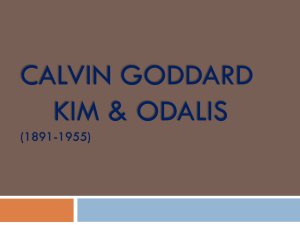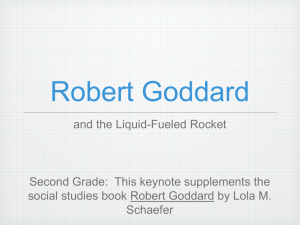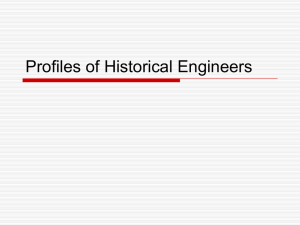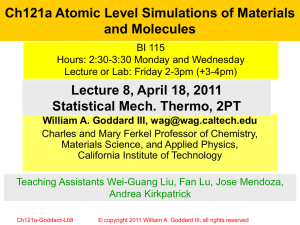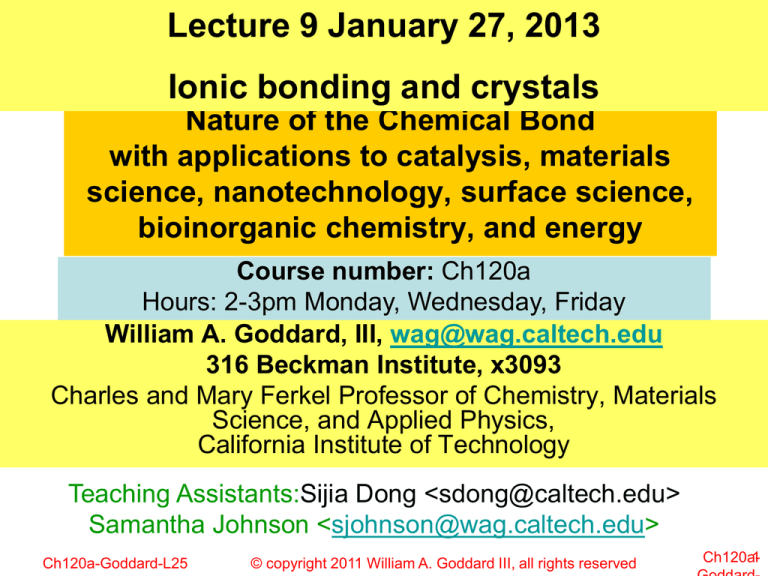
Lecture 9 January 27, 2013
Ionic bonding and crystals
Nature of the Chemical Bond
with applications to catalysis, materials
science, nanotechnology, surface science,
bioinorganic chemistry, and energy
Course number: Ch120a
Hours: 2-3pm Monday, Wednesday, Friday
William A. Goddard, III, wag@wag.caltech.edu
316 Beckman Institute, x3093
Charles and Mary Ferkel Professor of Chemistry, Materials
Science, and Applied Physics,
California Institute of Technology
Teaching Assistants:Sijia Dong <sdong@caltech.edu>
Samantha Johnson <sjohnson@wag.caltech.edu>
Ch120a-Goddard-L25
© copyright 2011 William A. Goddard III, all rights reserved
Ch120a1
Ionic bonding (chapter 9)
Consider the covalent bond of Na to Cl. There Is very little
contragradience, leading to an extremely weak bond.
Alternatively, consider
transferring the charge
from Na to Cl to form
Na+ and ClCh120a-Goddard-L25
© copyright 2011 William A. Goddard III, all rights reserved
2
The ionic limit
At R=∞ the cost of forming Na+ and Clis IP(Na) = 5.139 eV minus EA(Cl) = 3.615 eV = 1.524 eV
But as R is decreased the electrostatic energy drops as DE(eV) = 14.4/R(A) or DE (kcal/mol) = -332.06/R(A)
But covalent curve does not change until get large overlap
the ionic curve crosses the covalent curve at R=14.4/1.524=9.45 A
Using the bond distance
of NaCl=2.42A leads to a
coulomb energy of 6.1eV
Correcting for IP-EA at
R=∞ leads to a net bond
of 6.1-1.5=4.6 eV
experiment De = 4.23 eV
Thus ionic character
dominates
Ch120a-Goddard-L25
E(eV)
© copyright 2011 William A. Goddard III, all rights reserved
R(A)
3
GVB orbitals
of NaCl
No overlapno bond
R=6 A
Dipole moment
= 9.001 Debye
Overlap from Q transfer
Pure ionic
11.34 Debye
Thus Dq=0.79 e
R=4.7 A
Mostly Na+ ClR=3.5 A
Very Na+ Cl-
Re=2.4 A
Ch120a-Goddard-L25
© copyright 2011 William A. Goddard III, all rights reserved
4
electronegativity
To provide a measure to estimate polarity in bonds, Linus
Pauling developed a scale of electronegativity () where
the atom that gains charge is more electronegative and
the one that loses is more electropositive
He arbitrarily assigned
=4 for F, 3.5 for O, 3.0 for N, 2.5 for C, 2.0 for B, 1.5 for
Be, and 1.0 for Li
and then used various experiments to estimate other
cases . Current values are on the next slide
Mulliken formulated an alternative scale using atomic IP and
EA (corrected for valence averaging and scaled by 5.2 to get
similar numbers to Pauling: M= (IP+EA)/5.2
Ch120a-Goddard-L25
© copyright 2011 William A. Goddard III, all rights reserved
5
Electronegativity
Based on M++
Ch120a-Goddard-L25
© copyright 2011 William A. Goddard III, all rights reserved
6
Comparison of Mulliken and Pauling electronegativities
Mulliken Biggest flaw is the wrong value for H
H is clearly much less electronegative than I
Ch120a-Goddard-L25
© copyright 2011 William A. Goddard III, all rights reserved
7
Ionic crystals
Starting with two NaCl monomer, it is downhill by 2.10
eV (at 0K) for form the dimer
Because of repulsion between
like charges the bond lengths,
increase by 0.26A.
A purely electrostatic calculation would
have led to a bond energy of 1.68 eV
Similarly, two dimers can combine to form
a strongly bonded tetramer with a nearly
cubic structure
Continuing, combining 4x1018 such
dimers leads to a grain of salt in which
each Na has 6 Cl neighbors and each Cl
hasCh120a-Goddard-L25
6 Na neighbors © copyright 2011 William A. Goddard III, all rights reserved
8
The NaCl or B1 crystal
All alkali halides
have this
structure except
CsCl, CsBr, CsI
(they have the B2
structure)
Ch120a-Goddard-L25
© copyright 2011 William A. Goddard III, all rights reserved
9
The CsCl or B2 crystal
There is not yet a good understanding of the fundamental
reasons why particular compound prefer particular
structures. But for ionic crystals the consideration of ionic
radii has proved useful
Ch120a-Goddard-L25
© copyright 2011 William A. Goddard III, all rights reserved
10
Ionic radii, main group
Fitted to various crystals. Assumes O2- is 1.40A
NaCl R=1.02+1.81 = 2.84, exper is 2.84
From
R. D. Shannon, Acta©Cryst.
751 (1976)
Ch120a-Goddard-L25
copyrightA32,
2011 William
A. Goddard III, all rights reserved
11
Ionic radii, transition metals
HS
Fe3+ is d5 thus get HSS=5/2; LS=1/2 not important
Fe2+ is d6 thus HS=2; LS=0, both important
Ligand field splitting (Crystal field splitting)
Negative neighbors at vertices of octahedron splits the d orbitals
into t2g and eg irreducible representations of Td or Oh point group
Five d orbitals
same energy
atom
Ch120a-Goddard-L25
eg [x2-y2, 3z2-r2]
t2g [xy, xz, yz]
t2g [xy, xz, yz]
eg [x2-y2, 3z2-r2]
octahedron
tetrahedron
© copyright 2011 William A. Goddard III, all rights reserved
12
More on HS and LS, octahedral site, Fe3+
Fe3+ is d5 thus get HSS=5/2; LS=1/2 not important
Weak field
eg
t2g
Strong field
x2-y2
3z2-r2
xy
xz
yz
t2g
Exchange stabilization
dominates, get high
spin S=5/2 as for atom
5*4/2=10 exchange terms,
~220 kcal/mol
Ch120a-Goddard-L25
eg
x2-y2
3z2-r2
xy
xz
yz
Ligand interaction
dominates, get low spin
S=1/2
3+1 exchange terms
~88 kcal/mol
© copyright 2011 William A. Goddard III, all rights reserved
13
More on HS and LS, octahedral site, Fe2+
Fe2+ is d6 thus HS=2; LS=0, both important
Weak field
eg
t2g
Strong field
x2-y2
3z2-r2
xy
xz
yz
t2g
Exchange stabilization
dominates, get high
spin S=2 as for atom
5*4/2=10 exchange terms,
~220 kcal/mol
Ch120a-Goddard-L25
eg
x2-y2
3z2-r2
xy
xz
yz
Ligand interaction
dominates, get low spin
S=0
3+3 exchange terms
~132 kcal/mol
© copyright 2011 William A. Goddard III, all rights reserved
14
Ionic radii, transition metals
Ch120a-Goddard-L25
© copyright 2011 William A. Goddard III, all rights reserved
15
Ionic radii Lanthanides and Actinide
Ch120a-Goddard-L25
© copyright 2011 William A. Goddard III, all rights reserved
16
Role of ionic sizes in determining crystal structures
Assume that anions are large and packed so that they contact, then 2RA < L, L
is distance between anions
Assume anion and cation are in contact and calculate smallest cation
consistent with 2RA < L.
RA+RC = L/√2 > √2 RA
RA+RC = (√3)L/2 > (√3) RA
Thus RC/RA > 0.414
Thus RC/RA > 0.732
Thus for 0.414 < (RC/RA ) < 0.732 we expect B1
For (RC/RA ) > 0.732 either is ok.
ForCh120a-Goddard-L25
(RC/RA ) < 0.414 must
be2011
some
other
structure
© copyright
William A.
Goddard
III, all rights reserved
17
Radius Ratios of Alkali Halides and Noble metal halices
Rules work ok
B1: 0.35 to 1.26
B2: 0.76 to 0.92
B1
expecton
0.414
< (RC/RA ) < 0.732
Based
R. W.
G.B1
Wyckoff,
B2 or
(RC/RA ) > 0.732
Crystal
(RStructures,
neither
C/RA ) < 0.414
2nd
edition. Volume 1
(1963)
Ch120a-Goddard-L25
© copyright 2011 William A. Goddard III, all rights reserved
18
Sphalerite or Zincblende or B3 structure GaAs
Ch120a-Goddard-L25
© copyright 2011 William A. Goddard III, all rights reserved
19
Wurtzite or B4 structure
Ch120a-Goddard-L25
© copyright 2011 William A. Goddard III, all rights reserved
20
Radius ratios for B3, B4
The height of the tetrahedron is (2/3)√3 a where a is the side of
the circumscribed cube
The midpoint of the tetrahedron (also the midpoint of the cube) is
(1/2)√3 a from the vertex.
Hence (RC + RA)/L = (½) √3 a / √2 a = √(3/8) = 0.612
Thus 2RA < L = √(8/3) (RC + RA) = 1.633 (RC + RA)
Thus 1.225 RA < (RC + RA) or RC/RA > 0.225
Thus B3,B4 should be the stable structures for
0.225 < (RC/RA) < 0. 414
Ch120a-Goddard-L25
© copyright 2011 William A. Goddard III, all rights reserved
21
Structures for II-VI compounds
B3 for 0.20 < (RC/RA) < 0.55
B4 for 0.33 < (RC/RA) < 0.53
B1 for 0.36 < (RC/RA) < 0.96
Ch120a-Goddard-L25
© copyright 2011 William A. Goddard III, all rights reserved
22
CaF2 or fluorite structure
like B1, CsCl but with
half the Cs missing
Or Ca same positions
as Ga for GaAs, but
now have F at all
tetrahedral sites
Find for RC/RA > 0.71
Ch120a-Goddard-L25
© copyright 2011 William A. Goddard III, all rights reserved
23
Rutile (TiO2) or Cassiterite (SnO2) structure
Related to NaCl
with half the
cations missing
Find for RC/RA < 0.67
Ch120a-Goddard-L25
© copyright 2011 William A. Goddard III, all rights reserved
24
CaF2
rutile
CaF2
rutile
Ch120a-Goddard-L25
© copyright 2011 William A. Goddard III, all rights reserved
25
Stopped L17, Feb 10
Ch120a-Goddard-L25
© copyright 2011 William A. Goddard III, all rights reserved
26
Electrostatic Balance Postulate
For an ionic crystal the charges transferred from all cations
must add up to the extra charges on all the anions.
We can do this bond by bond, but in many systems the
environments of the anions are all the same as are the
environments of the cations. In this case the bond polarity
(S) of each cation-anion pair is the same and we write
S = zC/nC where zC is the net charge on the cation and nC is
the coordination number
Then zA = Si SI = Si zCi /ni
Example1 : SiO2. in most phases each Si is in a tetrahedron
of O2- leading to S=4/4=1.
Thus each O2- must have just two Si neighbors
Ch120a-Goddard-L25
© copyright 2011 William A. Goddard III, all rights reserved
27
a-quartz structure of SiO2
Each Si bonds to 4 O,
OSiO = 109.5°
each O bonds to 2 Si
Si-O-Si = 155.x °
Helical chains
single crystals optically active;
α-quartz converts to β-quartz
at 573 °C
From wikipedia
Ch120a-Goddard-L25
rhombohedral
(trigonal)
hP9, P3121
No.152[10]
© copyright 2011 William A. Goddard III, all rights reserved
28
Example 2 of electrostatic balance: stishovite phase of SiO2
The stishovite phase of SiO2 has six coordinate Si, S=2/3.
Thus each O must have 3 Si neighbors
Rutile-like structure, with 6coordinate Si;
high pressure form
densest of the SiO2
polymorphs
From wikipedia
Ch120a-Goddard-L25
tetragonal
tP6, P42/mnm,
No.136[17]
© copyright 2011 William A. Goddard III, all rights reserved
29
TiO2, example 3 electrostatic balance
Example 3: the rutile, anatase, and brookite phases of TiO2
all have octahedral Ti.
Thus S= 2/3 and each O must be coordinated to 3 Ti.
top
anatase phase TiO2
front
Ch120a-Goddard-L25
right
© copyright 2011 William A. Goddard III, all rights reserved
30
Corundum (a-Al2O3). Example 4 electrostatic balance
Each Al3+ is in a distorted octahedron,
leading to S=1/2.
Thus each O2- must be coordinated to 4 Al
Ch120a-Goddard-L25
© copyright 2011 William A. Goddard III, all rights reserved
31
Olivine. Mg2SiO4. example 5 electrostatic balance
Each Si has four O2- (S=1) and each
Mg has six O2- (S=1/3).
Thus each O2- must be coordinated to
1 Si and 3 Mg neighbors
O = Blue atoms (closest packed)
Si = magenta (4 coord) cap voids in
zigzag chains of Mg
Mg = yellow (6 coord)
Ch120a-Goddard-L25
© copyright 2011 William A. Goddard III, all rights reserved
32
Illustration, BaTiO3
A number of important oxides have the perovskite structure
(CaTiO3) including BaTiO3, KNbO3, PbTiO3.
Lets try to predict the structure without looking it up
Based on the TiO2 structures , we expect the Ti to be in an
octahedron of O2-, STiO = 2/3.
How many Ti neighbors will each O have?
Ch120a-Goddard-L25
© copyright 2011 William A. Goddard III, all rights reserved
33
Illustration, BaTiO3
A number of important oxides have the perovskite structure
(CaTiO3) including BaTiO3, KNbO3, PbTiO3.
Lets try to predict the structure without looking it up
Based on the TiO2 structures , we expect the Ti to be in an
octahedron of O2-, STiO = 2/3.
How many Ti neighbors will each O have?
It cannot be 3 since there would be no place for the Ba.
Ch120a-Goddard-L25
© copyright 2011 William A. Goddard III, all rights reserved
34
Illustration, BaTiO3
A number of important oxides have the perovskite structure
(CaTiO3) including BaTiO3, KNbO3, PbTiO3.
Lets try to predict the structure without looking it up
Based on the TiO2 structures , we expect the Ti to be in an
octahedron of O2-, STiO = 2/3.
How many Ti neighbors will each O have?
It cannot be 3 since there would be no place for the Ba.
It is likely not one since Ti does not make oxo bonds.
Ch120a-Goddard-L25
© copyright 2011 William A. Goddard III, all rights reserved
35
Illustration, BaTiO3
A number of important oxides have the perovskite structure
(CaTiO3) including BaTiO3, KNbO3, PbTiO3.
Lets try to predict the structure without looking it up
Based on the TiO2 structures , we expect the Ti to be in an
octahedron of O2-, STiO = 2/3.
How many Ti neighbors will each O have?
It cannot be 3 since there would be no place for the Ba.
It is likely not one since Ti does not make oxo bonds.
Thus we expect each O to have two Ti neighbors, probably at
180º. This accounts for 2*(2/3)= 4/3 charge.
Ch120a-Goddard-L25
© copyright 2011 William A. Goddard III, all rights reserved
36
Illustration, BaTiO3
A number of important oxides have the perovskite structure
(CaTiO3) including BaTiO3, KNbO3, PbTiO3.
Lets try to predict the structure without looking it up
Based on the TiO2 structures , we expect the Ti to be in an
octahedron of O2-, STiO = 2/3.
How many Ti neighbors will each O have?
It cannot be 3 since there would be no place for the Ba.
It is likely not one since Ti does not make oxo bonds.
Thus we expect each O to have two Ti neighbors, probably at
180º. This accounts for 2*(2/3)= 4/3 charge.
Now we must consider how many O are around each Ba, nBa,
leading to SBa = 2/nBa, and how many Ba around each O,
nOBa.
Ch120a-Goddard-L25
© copyright 2011 William A. Goddard III, all rights reserved
37
Illustration, BaTiO3
A number of important oxides have the perovskite structure
(CaTiO3) including BaTiO3, KNbO3, PbTiO3.
Lets try to predict the structure without looking it up
Based on the TiO2 structures , we expect the Ti to be in an
octahedron of O2-, STiO = 2/3.
How many Ti neighbors will each O have?
It cannot be 3 since there would be no place for the Ba.
It is likely not one since Ti does not make oxo bonds.
Thus we expect each O to have two Ti neighbors, probably at
180º. This accounts for 2*(2/3)= 4/3 charge.
Now we must consider how many O are around each Ba, nBa,
leading to SBa = 2/nBa, and how many Ba around each O,
nOBa.
Ch120a-Goddard-L25
© copyright 2011 William A. Goddard III, all rights reserved
38
Prediction of BaTiO3 structure : Ba coordination
Since nOBa* SBa = 2/3, the missing charge for the O, we have
only a few possibilities:
nBa= 3 leading to SBa = 2/nBa=2/3 leading to nOBa = 1
nBa= 6 leading to SBa = 2/nBa=1/3 leading to nOBa = 2
nBa= 9 leading to SBa = 2/nBa=2/9 leading to nOBa = 3
nBa= 12 leading to SBa = 2/nBa=1/6 leading to nOBa = 4
Each of these might lead to a possible structure.
The last case is the correct one for BaTiO3 as shown.
Each O has a Ti in the +z and –z directions plus four Ba
forming a square in the xy plane
The Each of these Ba sees 4 O in the xy plane, 4 in the xz
plane and 4 in the yz plane.
Ch120a-Goddard-L25
© copyright 2011 William A. Goddard III, all rights reserved
39
BaTiO3 structure (Perovskite)
Ch120a-Goddard-L25
© copyright 2011 William A. Goddard III, all rights reserved
40
How estimate charges?
We saw that even for a material as ionic as NaCl diatomic, the
dipole moment a net charge of +0.8 e on the Na and -0.8 e
on the Cl.
We need a method to estimate such charges in order to
calculate properties of materials.
First a bit more about units.
In QM calculations the unit of charge is the magnitude of the
charge on an electron and the unit of length is the bohr (a0)
Thus QM calculations of dipole moment are in units of ea0 which
we refer to as au. However the international standard for
quoting dipole moment is the Debye = 10-10 esu A
Where m(D) = 2.5418 m(au)
Ch120a-Goddard-L25
© copyright 2011 William A. Goddard III, all rights reserved
41
Fractional ionic character of diatomic molecules
Obtained from the experimental dipole moment in Debye, m(D), and bond
distance R(A) by dq = m(au)/R(a0) = C m(D)/R(A) where C=0.743470. Postive
42
© copyright 2011 William A. Goddard III, all rights reserved
thatCh120a-Goddard-L25
head of column is negative
Charge Equilibration
First consider how the energy of an atom depends on
the net charge on the atom, E(Q)
Including terms through 2nd order leads to
Charge Equilibration for Molecular
Dynamics Simulations;
A. K. Rappé and W. A. Goddard III;
J. Phys. Chem. 95, 3358 (1991)
(2)
Ch120a-Goddard-L25
© copyright 2011 William A. Goddard III, all rights reserved
(3)
43
Charge dependence of the energy (eV) of an atom
E=12.967
Harmonic fit
E=0
E=-3.615
Cl+
Q=+1
Cl
Q=0
Ch120a-Goddard-L25
ClQ=-1
= 8.291
Get minimum at Q=-0.887
Emin = -3.676
= 9.352
© copyright 2011 William A. Goddard III, all rights reserved
44
QEq parameters
Ch120a-Goddard-L25
© copyright 2011 William A. Goddard III, all rights reserved
45
Interpretation of J, the hardness
Define an atomic radius as
RA0
Re(A2) Bond distance of
homonuclear
H
0.84 0.74
diatomic
C
1.42 1.23
N
1.22 1.10
O
1.08 1.21
Si
2.20 2.35
S
1.60 1.63
Li
3.01 3.08
Thus J is related to the coulomb energy of a charge the size of the
46
Ch120a-Goddard-L25
© copyright 2011 William A. Goddard III, all rights reserved
atom
The total energy of a molecular complex
Consider now a distribution of charges over the
atoms of a complex: QA, QB, etc
Letting JAB(R) = the Coulomb potential of unit
charges on the atoms, we can write
Taking the derivative with respect to charge leads to the
chemical potential, which is a function of the charges
or
The definition of equilibrium is for all chemical potentials to be
equal.
This leads to © copyright 2011 William A. Goddard III, all rights reserved
Ch120a-Goddard-L25
47
The QEq equations
Adding to the N-1 conditions
The condition that the total charged is fixed (say at 0)
leads to the condition
Leads to a set of N linear equations for the N variables QA.
AQ=X, where the NxN matrix A and the N dimensional vector A
are known. This is solved for the N unknowns, Q.
We place some conditions on this. The harmonic fit of charge to
the energy of an atom is assumed to be valid only for filling the
valence shell.
Thus we restrict Q(Cl) to lie between +7 and -1 and
Q(C) to be between +4 and -4
Similarly Q(H) is between +1 and -1
Ch120a-Goddard-L25
© copyright 2011 William A. Goddard III, all rights reserved
48
The QEq Coulomb potential law
We need now to choose a form for JAB(R)
A plausible form is JAB(R) = 14.4/R, which is valid when the
charge distributions for atom A and B do not overlap
Clearly this form as the problem that JAB(R) ∞ as R 0
In fact the overlap of the orbitals leads to shielding
The plot shows the
shielding for C atoms using
various Slater orbitals
And l = 0.5
Ch120a-Goddard-L25
Using RC=0.759a0
© copyright 2011 William A. Goddard III, all rights reserved
49
QEq results for alkali halides
Ch120a-Goddard-L25
© copyright 2011 William A. Goddard III, all rights reserved
50
QEq for Ala-His-Ala
Amber
charges in
parentheses
Ch120a-Goddard-L25
© copyright 2011 William A. Goddard III, all rights reserved
51
QEq for deoxy adenosine
Amber
charges in
parentheses
Ch120a-Goddard-L25
© copyright 2011 William A. Goddard III, all rights reserved
52
QEq for polymers
Nylon 66
PEEK
Ch120a-Goddard-L25
© copyright 2011 William A. Goddard III, all rights reserved
53
Stopped January 30
Ch120a-Goddard-L25
© copyright 2011 William A. Goddard III, all rights reserved
54
Perovskites
Perovskite (CaTiO3) first described in the 1830s
by the geologist Gustav Rose, who named it
after the famous Russian mineralogist Count Lev
Aleksevich von Perovski
crystal lattice appears cubic, but it is actually
orthorhombic in symmetry due to a slight
distortion of the structure.
Characteristic chemical formula of a perovskite
ceramic: ABO3,
A atom has +2 charge. 12 coordinate at the
corners of a cube.
B atom has +4 charge.
Octahedron of O ions on the faces of that cube
centered on a B ions at the center of the cube.
Together A and B form an FCC structure
Ch120a-Goddard-L25
© copyright 2011 William A. Goddard III, all rights reserved
55
The stability of the perovskite structure depends on
the relative ionic radii:
Ferroelectrics
if the cations are too small for close packing with the
oxygens, they may displace slightly.
Since these ions carry electrical charges, such
displacements can result in a net electric dipole
moment (opposite charges separated by a small
distance).
The material is said to be a ferroelectric by analogy
with a ferromagnet which contains magnetic dipoles.
At high temperature, the small green B-cations can
"rattle around" in the larger holes between oxygen,
maintaining cubic symmetry.
A static displacement occurs when the structure is
cooled below the transition temperature.
Ch120a-Goddard-L25
© copyright 2011 William A. Goddard III, all rights reserved
56
Phases of BaTiO3
<111> polarized
rhombohedral
<110> polarized
orthorhombic
-90oC
<100> polarized
tetragonal
120oC
5oC
Non-polar
cubic
Temperature
Different phases of BaTiO3
Ba2+/Pb2+
c
Ti4+
O2-
a
Non-polar cubic
above Tc
Six variants at room temperature
c
1.01 ~ 1.06
a
<100> tetragonal
below Tc
Domains separated by domain walls
Ch120a-Goddard-L25
© copyright 2011 William A. Goddard III, all rights reserved
57
Nature of the phase transitions
Displacive model
Assume that the atoms prefer to
distort toward a face or edge or
vertex of the octahedron
Increasing
Temperature
Different phases of BaTiO3
<111> polarized
rhombohedral
<110> polarized
orthorhombic
-90oC
face
<100> polarized
tetragonal
120oC
5oC
edge
Non-polar
cubic
vertex
Temperature
center
1960 Cochran
Soft Mode Theory(Displacive Model)
Ch120a-Goddard-L25
© copyright 2011 William A. Goddard III, all rights reserved
58
Nature of the phase transitions
Displacive model
Assume that the atoms prefer to
distort toward a face or edge or
vertex of the octahedron
1960
Cochran
Increasing
Temperature
Soft Mode Theory(Displacive Model)
Order-disorder
1966
Bersuker
Eight Site Model
1968
Comes
Order-Disorder Model (Diffuse X-ray Scattering)
Ch120a-Goddard-L25
© copyright 2011 William A. Goddard III, all rights reserved
59
Comparison to experiment
Displacive small latent heat
This agrees with experiment
R O: T= 183K, DS = 0.17±0.04 J/mol
O T: T= 278K, DS = 0.32±0.06 J/mol
T C: T= 393K, DS = 0.52±0.05 J/mol
Diffuse xray scattering
Expect some disorder,
agrees with experiment
Cubic
Tetra.
Ortho.
Ch120a-Goddard-L25
© copyright 2011 William A. Goddard III, all rights reserved
Rhomb.
60
Problem displacive model: EXAFS & Raman observations
d
(001)
EXAFS of Tetragonal Phase[1]
•Ti distorted from the center of oxygen octahedral in tetragonal
phase.
α
(111)
•The angle between the displacement vector and (111) is α= 11.7°.
Raman Spectroscopy of Cubic Phase[2]
A strong Raman spectrum in cubic phase is found in experiments.
But displacive model atoms at center of octahedron: no Raman
1.
B. Ravel et al, Ferroelectrics, 206, 407 (1998)
2.
A. M. Quittet et al, Solid
State Comm.,
12, 1053
(1973) III, all rights reserved
Ch120a-Goddard-L25
© copyright
2011 William
A. Goddard
61
61
QM calculations
The ferroelectric and cubic phases in BaTiO3 ferroelectrics are also
antiferroelectric
Zhang QS, Cagin T, Goddard WA
Proc. Nat. Acad. Sci. USA, 103 (40): 14695-14700 (2006)
Even for the cubic phase, it is lower energy for the Ti
to distort toward the face of each octahedron.
How do we get cubic symmetry?
Combine 8 cells together into a 2x2x2 new unit cell,
each has displacement toward one of the 8 faces, but
they alternate in the x, y, and z directions to get an
overall cubic symmetry
Microscopic Polarization
Ti atom
distortions
Cubic
I-43m
Ch120a-Goddard-L25 z
=
Pz
Py
Px
+
Macroscopic
Polarization
+
© copyright 2011 William A. Goddard III, all rights reserved
=
62
QM results explain EXAFS & Raman observations
d
(001)
EXAFS of Tetragonal Phase[1]
•Ti distorted from the center of oxygen octahedral in tetragonal
phase.
α
(111)
•The angle between the displacement vector and (111) is α= 11.7°.
PQEq with FE/AFE model gives α=5.63°
Raman Spectroscopy of Cubic Phase[2]
A strong Raman spectrum in cubic phase is found in experiments.
1.
Model
Inversion symmetry in
Cubic Phase
Raman Active
Displacive
Yes
No
FE/AFE
No
Yes
B. Ravel et al, Ferroelectrics, 206, 407 (1998)
2.
A. M. Quittet et al, Solid
State Comm.,
12, 1053
(1973) III, all rights reserved
Ch120a-Goddard-L25
© copyright
2011 William
A. Goddard
63
63
stopped
Ch120a-Goddard-L25
© copyright 2011 William A. Goddard III, all rights reserved
64

